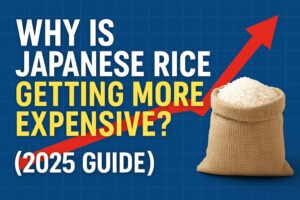Last Updated on 2025年9月13日 by Kenty
Japan’s Rice Crisis 2025
What Foreigners Need to Know About the 50% Price Surge
Crisis Overview
Japan’s staple food is experiencing an unprecedented price surge that’s reshaping daily life for millions, including the growing foreign resident population. Convenience store rice packs that cost ¥120 just one year ago now retail for ¥180 – a staggering 50% increase that signals deeper structural problems in Japan’s agricultural system.
¥60 Increase
Average price jump for convenience store rice packs
30 Years
Since the last comparable rice price crisis
¥15,600
Additional annual cost for a family of four
For the approximately 3 million foreign residents in Japan, this crisis presents unique challenges. Unlike many Japanese households with deep cultural ties to rice and established purchasing patterns, foreign residents often rely more heavily on convenient, pre-packaged rice products – exactly the segment hit hardest by price increases. This comprehensive guide explains what’s happening, why it matters, and how you can adapt.
The Price Surge: By the Numbers
Rice Price Changes (2022-2025)
Convenience Store Impact
Bulk Rice Prices
Impact on Foreign Resident Budgets
Single Person Household
- • Monthly rice consumption: ~3kg
- • Additional monthly cost: ¥800-1,200
- • Annual impact: ¥9,600-14,400
- • Budget increase: 2-3% of food expenses
Family of Four
- • Monthly rice consumption: ~10kg
- • Additional monthly cost: ¥1,300-2,000
- • Annual impact: ¥15,600-24,000
- • Budget increase: 4-6% of food expenses
Understanding the Causes
Climate Change Impact
Japan’s rice production has been severely disrupted by increasingly extreme weather patterns. The 2023 growing season saw devastating floods in the Tohoku region, followed by record-breaking heat waves that damaged crops across western Japan.
July 2023 Floods
15% of Tohoku rice fields submerged, causing massive crop losses
August Heat Wave
Record temperatures caused heat stress damage across western regions
Typhoon Season
Multiple strong typhoons destroyed crops just before harvest
Long-term Climate Trends
- • Average temperature increase: +1.2°C over 30 years
- • Rainfall pattern changes: More extreme dry and wet periods
- • Typhoon intensification: Stronger storms with higher damage potential
- • Growing season disruption: Earlier springs, hotter summers
Rising Production Costs
The cost of rice farming has skyrocketed due to global supply chain disruptions and geopolitical tensions affecting key agricultural inputs.
Fertilizer Price Explosion
Energy Costs
- • Agricultural fuel: +40% increase
- • Electricity for drying facilities: +100%
- • Transportation costs: +25%
Labor Shortage
- • Average farmer age: 68.4 years
- • Agricultural wages: +20% increase
- • Mechanization costs rising
Global Market Influences
Japan’s rice market, while traditionally protected, is increasingly influenced by global trends in food prices and agricultural commodities.
International Rice Prices
Asian rice markets have seen significant volatility:
- • Thai rice: +30% year-over-year
- • Vietnamese rice: +25% increase
- • Indian rice export restrictions
Currency Impact
Yen weakness affects import costs:
- • Import fertilizer costs up 40%
- • Agricultural machinery prices rising
- • Fuel import costs increasing
Government Response and Policies
Emergency Measures Implemented
The Japanese government has responded with a multi-pronged approach combining immediate price stabilization efforts with long-term agricultural modernization initiatives. However, the effectiveness of these measures remains to be seen.
National Level Initiatives
Price Stabilization
- Strategic Rice Reserve: Release of government stockpile to moderate prices
- Import Considerations: Evaluation of temporary import increases
- Price Monitoring: Enhanced surveillance of retail pricing practices
Farmer Support
- Direct Payments: ¥30,000 per hectare cultivation subsidy
- Equipment Subsidies: 50% support for agricultural machinery
- Disaster Recovery: Rapid compensation for weather-damaged crops
Smart Agriculture Initiatives
Long-term solutions focus on technological advancement to increase efficiency and resilience in rice production.
AI-Powered Farming
- • Weather prediction systems
- • Optimal planting timing
- • Yield forecasting models
Automation Technology
- • Drone-based monitoring
- • Autonomous tractors
- • Robotic harvesting
Climate Adaptation
- • Heat-resistant varieties
- • Flood-tolerant strains
- • Efficient water usage
Local Government Programs
New Farmer Recruitment
Addressing the aging farmer population through targeted programs for young people.
- • 2-year apprenticeships
- • Living expense support
- • Mentorship matching
- • Land acquisition assistance
- • Equipment financing
- • Market access support
Regional Branding Initiatives
Local governments are promoting premium rice brands to capture higher value markets and support farmer incomes through differentiation strategies.
Cultural and Social Impact
Understanding Rice in Japanese Culture
For foreign residents, it’s crucial to understand that rice in Japan is far more than just a carbohydrate. It’s deeply embedded in cultural identity, religious practices, and social customs. The current crisis touches the very heart of Japanese society.
The Sacred Grain
Religious and Spiritual Significance
- Shinto Traditions: Rice is offered to kami (spirits) in religious ceremonies
- Imperial Connection: The Emperor performs annual rice planting rituals
- Seasonal Festivals: Rice harvest celebrations throughout Japan
- New Year Customs: Mochi (rice cakes) are essential for celebrations
Daily Life Integration
- Meal Structure: “Ichijuu-sansai” (one soup, three dishes) centers on rice
- Language: “Gohan” means both rice and meal
- Social Customs: Finishing rice shows respect to farmers
- Educational Values: Children learn to appreciate every grain
Shifting Consumption Patterns
The price crisis is accelerating existing trends in Japanese food consumption, with significant implications for foreign residents trying to understand and integrate into Japanese society.
Rice Consumption Trends
Declining Trends
- • Daily rice consumption down 40% since 1980
- • Young people eating less rice
- • Western breakfast habits increasing
Price-Driven Changes
- • Switch to bread and noodles
- • Smaller portion sizes
- • Less frequent rice purchase
Premium Shifts
- • Higher quality rice demand
- • Regional specialty varieties
- • Organic and branded rice
Social and Economic Implications
Impact on Low-Income Households
Rice has traditionally been the most affordable source of calories in Japan. Price increases disproportionately affect:
- • Elderly pensioners on fixed incomes
- • Single-parent families
- • Students and young workers
- • Recent immigrants and refugees
Regional Economic Effects
Rice-producing regions face complex challenges balancing farmer income with consumer affordability:
- • Rural communities dependent on rice farming
- • Traditional food processing industries
- • Regional tourism based on rice culture
- • Agricultural equipment manufacturers
Practical Advice for Foreign Residents
Navigating the Crisis
As a foreign resident in Japan, you have both challenges and advantages in dealing with rising rice prices. Unlike Japanese families with generations of rice-buying habits, you can more easily adapt your diet. However, you may lack knowledge of the best places to buy rice or alternatives available.
Smart Shopping Strategies
Where to Buy Rice Cheaply
Costco and Bulk Stores
10-30kg bags at wholesale prices. Best for families or shared purchases.
JA (Agricultural Cooperatives)
Direct from farmers. Often has “A-kome” (lower grade but tasty) options.
Online Direct Sales
Farmers sell directly through Rakuten, Yahoo Shopping, or own websites.
Discount Chains
Don Quijote, Gyomu Super, Hanamasa for bulk purchases.
Timing and Quantity Tips
New Rice Season (October-December)
Freshest rice, but prices may be higher initially. Wait until January for better deals.
Bulk Buying Strategy
Buy 10-20kg if you have storage. Rice keeps well for 6-12 months when stored properly.
End-of-Month Sales
Many supermarkets discount rice at month-end to clear inventory.
Group Purchases
Organize with neighbors or coworkers to buy large quantities and split.
Alternative Staple Foods
Diversifying your staple food intake can help manage costs while maintaining nutrition. Here are culturally appropriate alternatives that many Japanese are also adopting:
Grains & Cereals
- • Barley (Ōmugi): ¥200-300/kg, high fiber
- • Mixed grains: Add to rice for volume
- • Quinoa: Expensive but nutritious
- • Oats: Cheap breakfast option
Noodles & Bread
- • Udon/Soba: Traditional alternatives
- • Pasta: Often cheaper per serving
- • Bread: Morning bread culture growing
- • Ramen: For occasional meals
Root Vegetables
- • Sweet potatoes: Filling and cheap
- • Regular potatoes: Versatile staple
- • Taro (Satoimo): Traditional substitute
- • Kabocha squash: Seasonal option
Cooking and Storage Optimization
Maximize Rice Value
Proper Washing Technique
Rinse until water runs clear to improve taste and texture, making smaller portions more satisfying.
Optimal Water Ratio
1:1.2 rice to water ratio. Too much water makes mushy rice that’s less filling.
Flavor Enhancement
Add kombu (kelp), sake, or oil for richer taste without extra rice.
Stretch with Vegetables
Mix in diced vegetables, mushrooms, or beans to increase volume nutritiously.
Storage and Preservation
Proper Storage Location
Cool, dark, dry place. Avoid kitchen heat and humidity. Refrigerator is ideal for small amounts.
Container Choice
Airtight containers prevent insects and moisture. Transfer from paper bags immediately.
Batch Cooking
Cook large amounts and freeze portions. Saves time and energy costs.
Leftover Management
Day-old rice is perfect for fried rice, rice balls, or ochazuke (tea rice).
Budget Planning for Foreign Residents
Monthly Rice Budget Guidelines
*Based on 2025 prices. Includes safety margin for continued increases.
Cost Management Strategies
- Track spending: Monitor rice costs separately to understand impact
- Rebalance diet: Reduce other food costs to accommodate rice price increases
- Group buying: Coordinate with other foreign residents for bulk purchases
- Seasonal adjusting: Buy more when prices are lower, less when high
Future Outlook and Predictions
What to Expect
Based on expert analysis and current trends, here’s what foreign residents can expect regarding rice prices and availability in Japan over the coming years.
Short-term Forecast (2025-2027)
2025 Expectations
- • Continued price increases: 10-15%
- • Supply chain stabilization efforts
- • Government intervention effects
- • Weather dependency remains high
2026 Projections
- • Price growth slowing: 5-8%
- • Technology adoption beginning
- • New crop varieties introduction
- • International market stabilization
2027 Outlook
- • Price stabilization expected
- • Smart farming impact visible
- • Supply-demand rebalancing
- • Consumer adaptation complete
Key Factors to Monitor
- • Continued climate volatility
- • Energy costs remaining high
- • International fertilizer prices
- • Yen exchange rate weakness
- • Government subsidy programs
- • Technology efficiency gains
- • New climate-resistant varieties
- • Consumer behavior adaptation
Long-term Structural Changes (2028-2035)
The rice crisis is likely to accelerate fundamental changes in Japanese agriculture and food culture that will reshape the landscape for future foreign residents.
Agricultural Revolution
- • AI-driven farming becomes standard
- • Autonomous machinery widespread adoption
- • Precision agriculture optimization
- • Vertical farming expansion
- • Small farms merge into larger operations
- • Corporate farming expansion
- • Supply chain integration
- • Brand-focused production
Cultural Adaptation
- • Premium rice market dominance
- • Mixed-grain consumption increase
- • International cuisine integration
- • Functional food development
- • Rice as occasional luxury
- • Cultural preservation efforts
- • Educational program changes
- • Tourism industry adaptation
Market Structure Evolution
The rice market is expected to bifurcate into distinct segments:
- • High-quality branded rice
- • Organic and specialty varieties
- • Direct-to-consumer sales
- • Restaurant and export focus
- • Efficient mass production
- • Mixed-grain products
- • Processed food applications
- • Competitive pricing focus
Expert Analysis and Predictions
Agricultural Economics Professor, University of Tokyo
“The current rice crisis represents a fundamental shift rather than a temporary disruption. We’re witnessing the transformation of Japanese agriculture from a protected, traditional system to a technology-driven, market-responsive industry. Foreign residents should expect rice to remain expensive but become more diverse in quality and options.”
Dr. Tanaka Hiroshi, Agricultural Economics Department
Food Industry Analyst, Nomura Research Institute
“By 2030, we predict rice consumption patterns will stabilize at about 70% of current levels, but with 40% higher average prices. The market will split between premium domestic rice for special occasions and affordable mixed-grain products for daily consumption. Foreign residents who adapt early will have significant advantages.”
Sato Yuki, Senior Food Market Analyst
Climate Research Scientist, RIKEN
“Climate projections indicate that extreme weather events affecting rice production will become more frequent. However, Japan’s investment in climate-resistant varieties and controlled-environment agriculture should help stabilize production by the early 2030s. The key is managing the transition period.”
Dr. Yamamoto Kenji, Climate Impact Research Division
Conclusion: Adapting to Japan’s New Rice Reality
Japan’s rice crisis represents more than just rising food prices—it’s a fundamental shift in one of the country’s most cherished cultural institutions. For foreign residents, this crisis presents both challenges and opportunities to better understand and integrate with Japanese society.
Key Takeaways
- Rice prices have increased 50% and will likely remain elevated for several years
- Climate change and rising production costs are the primary drivers
- Government interventions may moderate but won’t eliminate increases
- Foreign residents can adapt more easily than Japanese families
- The crisis accelerates existing changes in Japanese food culture
Moving Forward
- Diversify your staple foods beyond rice
- Learn smart shopping strategies for bulk purchases
- Connect with other foreign residents for group buying
- Understand the cultural significance to better integrate
- Stay informed about ongoing developments and policy changes
A Note of Optimism
While the current rice crisis presents real challenges, it also offers foreign residents a unique opportunity to witness and participate in Japan’s adaptation to changing global conditions. By understanding both the practical and cultural dimensions of this issue, you can not only manage your own household budget more effectively but also gain deeper insights into Japanese society and its remarkable capacity for resilience and innovation.
Stay informed about Japan’s evolving food landscape and continue adapting alongside your Japanese neighbors as the country navigates this historic transition.





